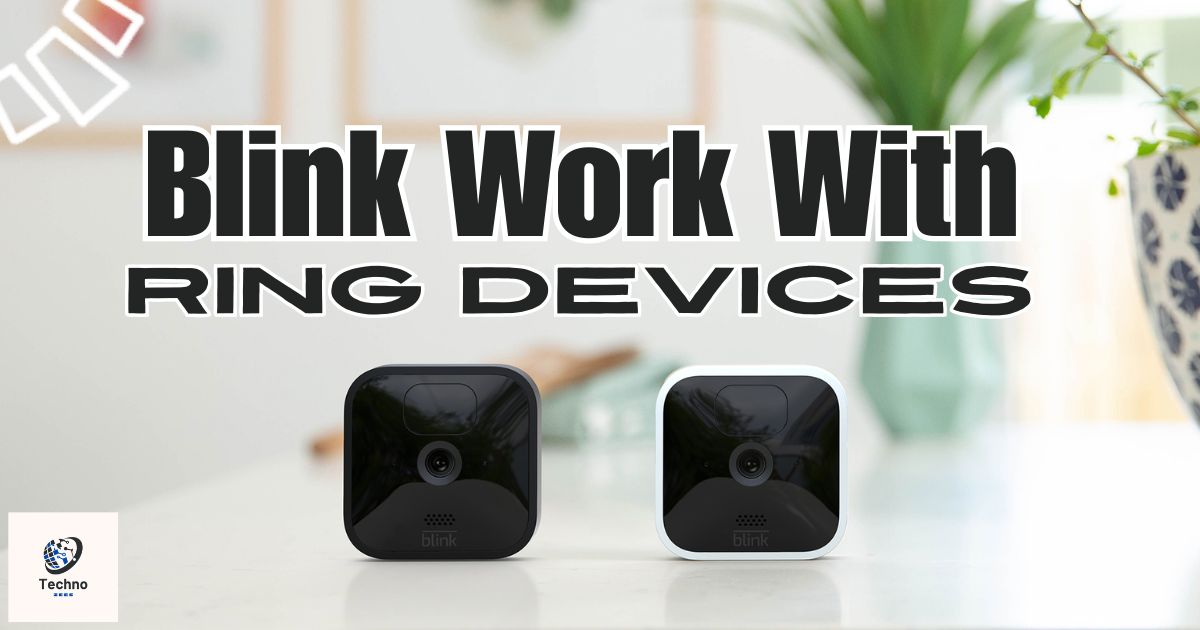Blink and Ring are popular smart home security brands owned by Amazon. They offer various devices like cameras, doorbells, and alarms to protect homes. “Blink Working With Ring Devices” refers to the potential integration or compatibility between these two separate ecosystems, allowing users to control and manage both systems together seamlessly.
Many homeowners ask, “Does Blink Work With Ring Devices?” when building their smart security setup. Imagine controlling your entire home security system with a single app or voice command. The prospect of combining Blink’s long battery life with Ring’s advanced features is enticing. But is it possible? Let’s move in and find out.
While Blink and Ring are both under the Amazon umbrella, they weren’t designed to work together out of the box. However, workarounds and third-party solutions can help bridge the gap between these two systems. Understanding these options can help you create a more comprehensive and efficient home security setup.
The Lowdown on Blink and Ring
Before we tackle the compatibility question, let’s get acquainted with our main players. Blink, a company acquired by Amazon in 2017, has made quite a splash in the smart home security market with its lineup of wireless, battery-powered cameras. Known for their long battery life and easy setup, Blink cameras have become a go-to choice for many homeowners looking for a no-fuss security solution.
On the other hand, Ring, another Amazon-owned company, offers a wider range of smart video doorbells and security devices. From their iconic video doorbells to floodlight cameras and alarm systems, Ring has positioned itself as a one-stop shop for home security needs.
Now, you might wonder, “Why would someone want to use both systems?” Well, each brand has its strengths. Blink’s simplicity and battery life might be perfect for monitoring your backyard, while Ring’s video doorbell could be your front door sentinel. The dream? Having these devices work together in perfect harmony.
Are Blink and Ring Devices Compatible?
Let’s cut to the chase Blink and Ring devices are not natively compatible. I know it’s a bit of a bummer. Despite both being under the Amazon umbrella, these two systems operate on different technological ecosystems. It’s like having two really cool friends who just don’t speak the same language.
But don’t lose hope! While they can’t directly communicate with each other, some clever workarounds can help you integrate Blink and Ring devices into a more cohesive system. These solutions involve using third-party platforms to act as translators between your Blink and Ring devices.
Why Aren’t They Compatible?
There are several reasons why Blink and Ring devices don’t work together seamlessly:
- Proprietary Technology: Each brand has developed its own unique technological architecture and communication protocols. It’s like they’re speaking two different languages, making direct communication impossible without a translator.
- Separate Ecosystems: Blink and Ring have each built their own ecosystem of devices and services. Blink focuses on simplicity and long battery life, while Ring offers a wider range of products with more advanced features. These different approaches make direct integration challenging.
- Business Strategy: Keeping the systems separate allows Amazon to cater to different market segments. Blink appeals to users who prioritize simplicity and affordability, while Ring targets those looking for more comprehensive and feature-rich solutions.
- Technical Challenges: Integrating two complex systems without compromising their strengths and security features is no small feat. It would require significant technical resources and collaboration between the two brands.
- User Data and Privacy: Each system takes a different approach to handling user data and privacy. Integrating them could potentially create complications in terms of data management and user privacy protection.
How to Pair Up Ring and Blink Devices
Now, let’s get to the good stuff. How can we make these two play nice? The secret lies in smart home integration platforms. Two main contenders stand out: Amazon Alexa and IFTTT (If This Then That). Let’s explore how each of these can help bridge the gap between your Blink cameras and Ring devices.
Integration via Alexa Routines
Amazon’s Alexa is like the Switzerland of smart home devices, neutral and ready to help everyone get along. Here’s how you can use Alexa routines to create some magic:
Download and Set Up Alexa Skills
- Open the Alexa app on your smartphone.
- Tap on “More” and select “Skills & Games.”
- Search for “Blink SmartHome” and “Ring” skills.
- Enable both skills and link your accounts.
Creating an Alexa Routine
Now that Alexa is on speaking terms with both your Blink and Ring devices, it’s time to create some routines:
- In the Alexa app, go to “Routines.”
- Tap the “+” to create a new routine.
- Set up a trigger (e.g., when your Blink camera detects motion).
- Add an action (e.g., turn on your Ring Floodlight Cam).
Integration via IFTTT Automation
If Alexa is the Switzerland of smart homes, IFTTT is the United Nations. This powerful platform can connect a vast array of devices and services, including our friends Blink and Ring.
Download and Set Up IFTTT
- Download the IFTTT app and create an account.
- Search for Blink and Ring services.
- Connect both services to your IFTTT account.
Creating an IFTTT Integration
IFTTT uses “applets” to connect different services. Here’s how to create one:
- In the IFTTT app, tap “Create.”
- Choose Blink as your “If This” trigger.
- Select Ring as your “Then That” action.
- Customize your applet (e.g., If Blink detects motion, then Ring starts recording).
Main Differences Between Ring and Blink Security Systems
While we’re on the topic of integrating these two systems, it’s worth noting their key differences. Understanding these can help you leverage each system’s strengths in your smart home setup.
Hardware
Blink focuses primarily on cameras, offering indoor, outdoor, and mini options. Their cameras are known for their compact size and impressive battery life. On the other hand, Ring offers a wider range of devices, including doorbells, floodlight cameras, and even alarm systems.
Sync Module
Blink cameras typically require a Sync Module to communicate with your network, while Ring devices connect directly to your Wi-Fi. This means Ring devices are often easier to set up, but Blink’s Sync Module can help extend battery life.
Payment Options
Both companies offer subscription plans, but they differ in structure:
| Feature | Blink | Ring |
| Basic Plan | $3/month per device | $3/month per device |
| Premium Plan | $10/month for unlimited devices | $10/month for unlimited devices |
| Video History | 60 days | 60 days |
| Free Cloud Storage | Limited (for older models) | None |
Installation
Both Blink and Ring offer DIY installation options, making them accessible to most homeowners. However, Ring also offers professional installation services for those who prefer a hands-off approach.
Storage
Blink offers both cloud and local storage options, while Ring focuses primarily on cloud storage. This gives Blink a slight edge for those concerned about privacy or internet outages.
Product Range
As mentioned earlier, Blink specializes in cameras, while Ring offers a broader range of security products. This makes Ring a more comprehensive solution for those looking to secure their entire home.
App
Both companies offer user-friendly apps, but they have different focuses:
- The Blink app emphasizes simplicity and quick access to live views.
- The Ring app offers more advanced features, including integrating the Neighbors app for community alerts.
Comparing Blink and Ring Cameras
When it comes to the cameras themselves, both Blink and Ring offer quality options. Let’s break down some key similarities and differences:
Similarities
- Both offer HD video quality and night vision capabilities.
- Two-way audio is available on most models from both brands.
- Motion detection is a standard feature across the board.
Differences
- Battery Life: Blink cameras generally boast longer battery life.
- Field of View: Ring cameras often offer a wider field of view.
- Advanced Features: Ring tends to offer more advanced features like person detection and customizable motion zones.
Read More: Simple Steps To Find LG TV MAC Address: Your Ultimate Guide
FAQs
Can Blink be used with Ring?
Blink and Ring aren’t directly compatible but can be integrated using third-party platforms like Amazon Alexa or IFTTT. This allows for some coordinated actions between the two systems.
What devices is Blink compatible with?
Blink cameras are compatible with Amazon Alexa devices, smartphones running the Blink app, and some third-party smart home platforms. They also work with other Blink products within their ecosystem.
Will other cameras work with Ring?
Ring primarily works with its own branded cameras. However, some third-party cameras can be integrated with Ring through platforms like IFTTT, though functionality may be limited compared to native Ring devices.
Are Ring and Blink the same company?
Ring and Blink are separate companies, but both are owned by Amazon. They operate as distinct brands with their own product lines and ecosystems within the smart home security market.
Conclusion
While Blink cameras and Ring devices don’t work together out of the box, you can create a smart home security system that combines their strengths. With platforms like Alexa and IFTTT, you can bridge the gap between these two popular brands. Whether you prefer Blink’s long battery life or Ring’s comprehensive ecosystem, there’s a way to make them work in harmony.
The goal of any home security system is peace of mind, and by integrating Blink and Ring, you’re not just securing your home. You’re outsmarting potential threats. So, experiment with routines and applets to create your perfect setup. While native integration between these Amazon-owned brands may come in the future, you can enjoy the benefits of both systems working together.

As a seasoned blog writer with three years of experience, I specialize in delivering insightful and informative content on global technology trends through my personal blog, TechnoZees.

